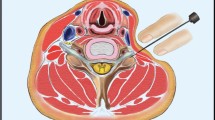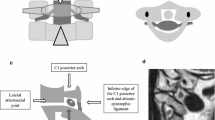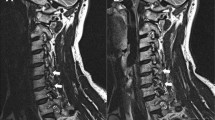Abstract
In patients with radiculopathy due to degenerative disease in the cervical spine, surgical outcome is still presenting with moderate results. The preoperative investigations consist of clinical investigation, careful history and most often magnetic resonance imaging (MRI) of the cervical spine. When MRI shows multilevel degeneration, different strategies are used for indicating which nerve root/roots are affected. Some authors use selective diagnostic nerve root blocks (SNRB) for segregating pain mediating nerve roots from non-pain mediators in such patients. The aim of the present study is to assess the ability of transforaminal SNRB to correlate clinical symptoms with MRI findings in patients with cervical radiculopathy and a two-level MRI degeneration, on the same side as the radicular pain. Thirty consecutive patients with cervical radiculopathy and two levels MRI pathology on the same side as the radicular pain were studied with SNRBs at both levels. All patients underwent clinical investigation and neck and arm pain assessment with visual analogue scales (VAS) before and after the blocks. The results from the SNRBs were compared to the clinical findings from neurological investigation as well as the MRI pathology and treatment results. Correlation between SNRB results and the level with most severe degree of MRI degeneration were 60% and correlation between SNRB results and levels decided by neurological deficits/dermatome radicular pain distribution were 28%. Twenty-two of the 30 patients underwent treatment guided by the SNRB results and 18 reported good/excellent outcome results. We conclude that the degree of MRI pathology, neurological investigation and the pain distribution in the arm are not reliable parameters enough when deciding the affected nerve root/roots in patients with cervical radiculopathy and a two-level degenerative disease in the cervical spine. SNRB might be a helpful tool together with clinical findings/history and MRI of the cervical spine when performing preoperative investigations in patients with two or more level of degeneration presenting with radicular pain that can be attributed to the degenerative findings.


Similar content being viewed by others
References
Akkerveeken van PF (1993) The diagnostic value of nerve root sheath infiltration. Acta Orthop 64(Suppl 251):61–63
Arner S, Lindblom U, Meyerson BA, Molander C (1990) Prolonged relief of neuralgia after regional anesthetic blocks. A call for further experimental and systematic clinical studies. Pain 43:287–297
Benini A (1987) Clinical features of cervical root compression C5-C8 and their variations. Neuro-Orthopedics 4:74–88
Benzel EC, Hart BL, Ball PA, Baldwin NG, Orrison WW, Espinosa MC (1986) Magnetic resonance imaging for the evaluation of patients with occult cervical spine injury. J Neurosurg 85:824–829
Boden SD, McCowin PR, Davis DO, Dina TS, Mark AS, Wiesel S. (1990) Abnormal magnetic resonance scans of the cervical spine in asymptomatic subjects. J Bone Joint Surg Am 72-A(8):1178–1184
Bogduk N, Marsland A(1988) The cervical zygapophyseal joints as a source of neck pain. Spine 13:610–617
Brouwers PJ, Kottink EJ, Simon MA, Prevo RL (2001) A spinal artery syndrome after diagnostic blockade of the right C6-nerve root. Pain 91:397–399
Burak MO, Lawrence FM (2003) Atypical presentation of C-7 radiculopathy. J Neurosurg (Spine 2) 99:169–171
Furman MB, Giovanniello MT, O’Brien EM (2003) Incidence of intravascular penetration in transforaminal cervical epidural steroid injections. Spine 28:21–25
Hildebrandt. J (2001) Relevance of nerve blocks in treating and diagnosing low back pain: is the quality decisive? Schmerz 15:474–483
Jönsson B, Strömqvist B, Annertz M, Holtås S, Sundén G (1988) Diagnostic lumbar nerve root block. J Spinal Disord Tech 3:232–235
Kikuchi S, Macnab P, Moreu P (1981) Localization of the level of symptomatic cervical disc degeneration. J Bone Joint Surg Br 2:272–277
Kikuchi S (1982) Anatomical and experimental studies of nerve root infiltration. Nippon Seikeigeka Gakkai Zasshi 56:605–614
Kinard RE (1996) Diagnostic spinal injection procedures. Neurosurg Clin N Am 17:15–165
Kinura J (1989) Electrodiagnosis in diseases of nerve and muscle: principles and practise, 2nd edn. FA Davis company, Philadelphia
Koppert W, Ostermeier N, Sittl R, Weidner C, Schmelz M (2000) Low-dose lidocaine reduces secondary hyperalgesia by a central mode of action. Pain 85:217–224
Lehto IJ, Tertti MO, Komu ME, Paajanen HEK, Tuominen J, Kormano MJ (1994) Age related MRI changes at 0.1 T in cervical discs in asymptomatic subjects. Neuroradiology 36:49–53
Manifold SG, McCann PD (1999) Cercvical radiculitis and shoulder disorders. Clin Orthop 368:105–113
Muhle C, Bischoff L, Weinert D, Lindner V, Falliner A, Maier C (1998) Exacerbated pain in cervical radiculopathy at axial rotation, flexion, extension, and coupled motions of the cervical spine. Evaluation by kinematic magnetic resonance imaging. Invest Radiol 5:279–288
Odom GL, Finney W, Woodhall B (1958) Cervical disc lesions. JAMA 166:23–28
Ongoiba N, Destrieux C, Koumare AK (2002) Anatomical variations of the brachial plexus. Morphologie 86:31–34
Perneczky A, Sunder-Plassman M (1980) Intradural variant of cervical nerve root fibres. Potential cause of misinterpreting the segmental location of cervical disc prolapses from clinical evidence. Acta Neurochir 52:9–83
Rozin L, Rozin R, Koehler SA, Shakir A, Ladham S, Barmada M, Dominick J, Wecht CH (2003) Death during transforaminal epidural steroid nerve root block (C7) due to perforation of the left vertebral artery. Am J Forensic Med Pathol 24:351–355
Saal JS (2002) General principles of diagnostic testing as related to painful lumbar spine disorders: a critical appraisal of current diagnostic techniques. Spine 15;27(22):2538–2545
Sampath P, Bendebba M, Davis J, Ducker D (1999) Outcome in patients with Cervical radiculopathy. Spine 24:591–597
Schellhas KP, Smith MD, Gundry CR, Pollei RS (1996) Cervical discogenic pain. Prospective correlation of magnetic resonance imaging and discography in asymptomatic subjects and pain sufferers. Spine 3:300–312
Siivola SM, Levoska S, Tervonen O, Ilkko E, Vanharanta H, Keinanen-Kiukaanniemi S (2002) MRI changes of the cervical spine in asymptomatic and symptomatic young adults. Eur Spine J 11:358–363
Slipman CW, Plastaras CT, Palmitier RA, Huston CW, Sterenfeld EB (1998) Symptom provocation of fluoroscopically guided cervical nerve root stimulation. Are dynatomal maps identical to dermatomal maps? Spine 1523:2235–2242
Slipman CW, Lipetz JS, Jackson HB, Rogers DP, Vresilovic EJ (2000) Therapeutic selective nerve root block in the nonsurgical treatment of atraumatic cervical spondylotic radicular pain. Arch Phys Med Rehabil 81:741–746
Yregard L, Cassuto J, Tarnow P, Nilsson U (2003) Influence of local anaesthetics on inflammatory activity postburn. Burns 29:335–341
Acknowledgement
Thanks to Liselott Persson, RPT, Department of Neurosurgery, for assistance with the evaluation of the patients.
Author information
Authors and Affiliations
Corresponding author
Rights and permissions
About this article
Cite this article
Anderberg, L., Annertz, M., Rydholm, U. et al. Selective diagnostic nerve root block for the evaluation of radicular pain in the multilevel degenerated cervical spine. Eur Spine J 15, 794–801 (2006). https://doi.org/10.1007/s00586-005-0931-5
Received:
Revised:
Accepted:
Published:
Issue Date:
DOI: https://doi.org/10.1007/s00586-005-0931-5




